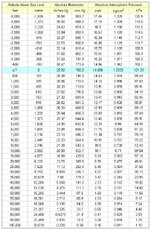C
I posted this over in the doo turbo forum, But this is one of the most active turbo forums and I think most would learn alot.
I found a great article on autospeed.com with equations showing how to calculate pressure drop from air temperature increases, intercooled and non intercooled efficency, and Non turbo pressure ratio (a number that would represent how much the turbocharged engine was boosted as if it were pure atmosphere pressure (like a labratory) and un-assisted. by a turbo or supercharger.) It explains perfectly why when the intake pressure is doubled, horsepower isnt doubled because of efficency.
Heres the link to the article.
http://autospeed.com/cms/title_Intercooler-Maths/A_109789/article.html
I tried to copy the article here, but no matter what i did the math formula's looked messed up no matter how I edited it. For some reason the forum software defaults on align left for text. It won't let me manually move text around to make the formula's look normal. Even if i align center the formula's.
If someone can figure this out i'd be glad to put the entire article up on here for easy reference. Thanks.
Enjoy!
I found a great article on autospeed.com with equations showing how to calculate pressure drop from air temperature increases, intercooled and non intercooled efficency, and Non turbo pressure ratio (a number that would represent how much the turbocharged engine was boosted as if it were pure atmosphere pressure (like a labratory) and un-assisted. by a turbo or supercharger.) It explains perfectly why when the intake pressure is doubled, horsepower isnt doubled because of efficency.
Heres the link to the article.
http://autospeed.com/cms/title_Intercooler-Maths/A_109789/article.html
I tried to copy the article here, but no matter what i did the math formula's looked messed up no matter how I edited it. For some reason the forum software defaults on align left for text. It won't let me manually move text around to make the formula's look normal. Even if i align center the formula's.
If someone can figure this out i'd be glad to put the entire article up on here for easy reference. Thanks.
Enjoy!



